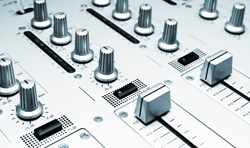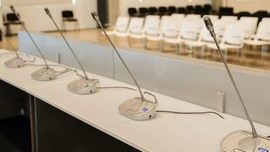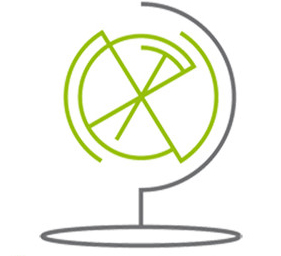Nordest Traduzioni
can rely on the collaboration of professionals with university degrees, perfectly capable of performing their role as language and cultural intermediaries, assisting the clients in the companies or professional offices and during fairs, conferences, business trips, etc. Our team has interpreters who are equipped to handle a range of topics (technical, economic and business, medical, legal, etc.) guaranteeing the maximum professional skill, helpfulness and confidentiality.
Nordest Traduzioni can also assist the client in the preparation of conference sites, furnishing booths and audio-visual systems.



Types of interpreting

CONSECUTIVE
The interpreter is generally seated next to the speaker and listens to the presentation, taking notes and translating complete passages (from 2-3 min. up to a maximum of 10-15 min.) This form of interpreting is suitable for smaller meetings (such as training courses, workshops) and brief presentations. It is not recommended if more than one foreign language is involved. With respect to simultaneous interpreting, it requires more time (almost double the amount) but does not require any technical equipment or assistance.
SIMULTANEUS
The speaker’s words are translated in an acoustically isolated booth by an interpreter equipped with headphones in real time, accurately and effectively. This type of interpreting is best suited to international events with a large number of participants as it allows the audience to listen to the presentations, each in his or her own language, using the headsets available. In this case is it indispensable to install booths for the interpreters. For every work session that exceeds half an hour, there must be two interpreters in the booth so that they can alternate.
TOUR GUIDE OR BIDULE
This type of interpreting uses a portable system (also known as valisette or tour guide system).
The interpreter has a radiomicrophone tuned to the same frequency as the receivers given to the participants. The interpreter translates simultaneously while listening without the use of a headset. In consideration of the lower cost, it is appropriate for small meetings where the use of a traditional booth would be too expensive. The use of bidule equipment is not appropriate if more than one foreign language is used, so it is not really a valid replacement for a simultaneous interpreting service.
CHUCHOTAGE
The interpreter “whispers” the simultaneous translation to the listener. A maximum of two listeners is admissible for this type of interpreting. No technical instrumentation is used. This form of interpreting is inappropriate if there is more than one foreign language.

SIGN LANGUAGE INTERPRETERS (SLI)
A sign language interpreter is someone who bridges the communication gap between deaf and hearing individuals. They act as a translator, converting spoken language into sign language and vice versa. This ensures that deaf and hard-of-hearing people have equal access to information and can participate in various settings.
Sign language interpreters are highly skilled professionals who undergo rigorous training. They must also possess a deep understanding of cultural nuances to ensure accurate and clear communication.
RECOMMENDATIONS FOR USERS WHO DECIDE TO RESORT TO INTERPRETING SERVICES
“From the user’s standpoint”
PROS OF SIMULTANEOUS TRANSLATION
◗ Savings of time, from an organizational standpoint.
◗ The audience is not forced to listen to different languages, which had definite advantages in terms of the attention span.

CONS OF SIMULTANEOUS TRANSLATION
◗ Requires the installation of technical equipment: booth, amplification system and headsets. The equipment is a necessary but costly addition to the event budget.
◗ Requires technical assistance for the entire duration of the event.
Conference centers are often already equipped with fixed booths (standard ISO 2603) for simultaneous translation, but just as often they are not, and it is necessary to rent portable booths (standard ISO 4043).
In this case, in addition to the normal cost of technical assistance, it is necessary to provide also for the cost of installing and removing them before and after the event.
PROS OF CONSECUTIVE TRANSLATION
◗ Almost no technical aids are necessary, except in very large auditoriums in which the use of a microphone is recommended to facilitate the listeners and which, in any case, will have been used by the speaker as well (and thus is not an additional cost).
◗ The speaker has more direct contact with the person conveying the message in the other language.
CONS OF CONSECUTIVE TRANSLATION
◗ More time will obviously be required for consecutive translation.
◗ There is a greater risk that the audience will lose the train of thought as the people will have to wait for the interpreter to finish the translation before allowing the speaker to resume the presentation.
◗ For speakers, consecutive translation may be irritating because they are forced to interrupt the presentation. For this reason it is a good idea to inform the speaker before the event that the translation will be consecutive. A speaker who is already familiar with the method will be able to break up the presentation to suit the situation.
Simultaneous vs. consecutive interpreting
In simultaneous interpreting
the interpreter listens to a source language and translates, speaking in a target language. The actions of listening and translating are, as the word itself suggests, simultaneous.
In consecutive interpreting
the interpreter listens to a speaker who speaks for a certain amount of time, usually up to 15 minutes, takes notes using a special technique based on training and personal experience and, after interrupting the speaker, presents the message expressed in the source language, speaking in the required target language.
In liaison interpreting
the interpreter translates orally for small groups of people, ensuring that they all understand one another, during sales negotiations or in the explanation of how a machine works, for example.
This is a technique used in informal situations, in which both parties can interrupt each other and interact without a strict program of presentation.
The difference between simultaneous and consecutive interpreting thus lies in the technique of language transfer applied to the need to translate one or more presentations during a conference; liaison interpreting applies to different sectors and situations, characterized by the informality of the meeting, the presence of two parties and the possibility of interrupting each other in turn.
